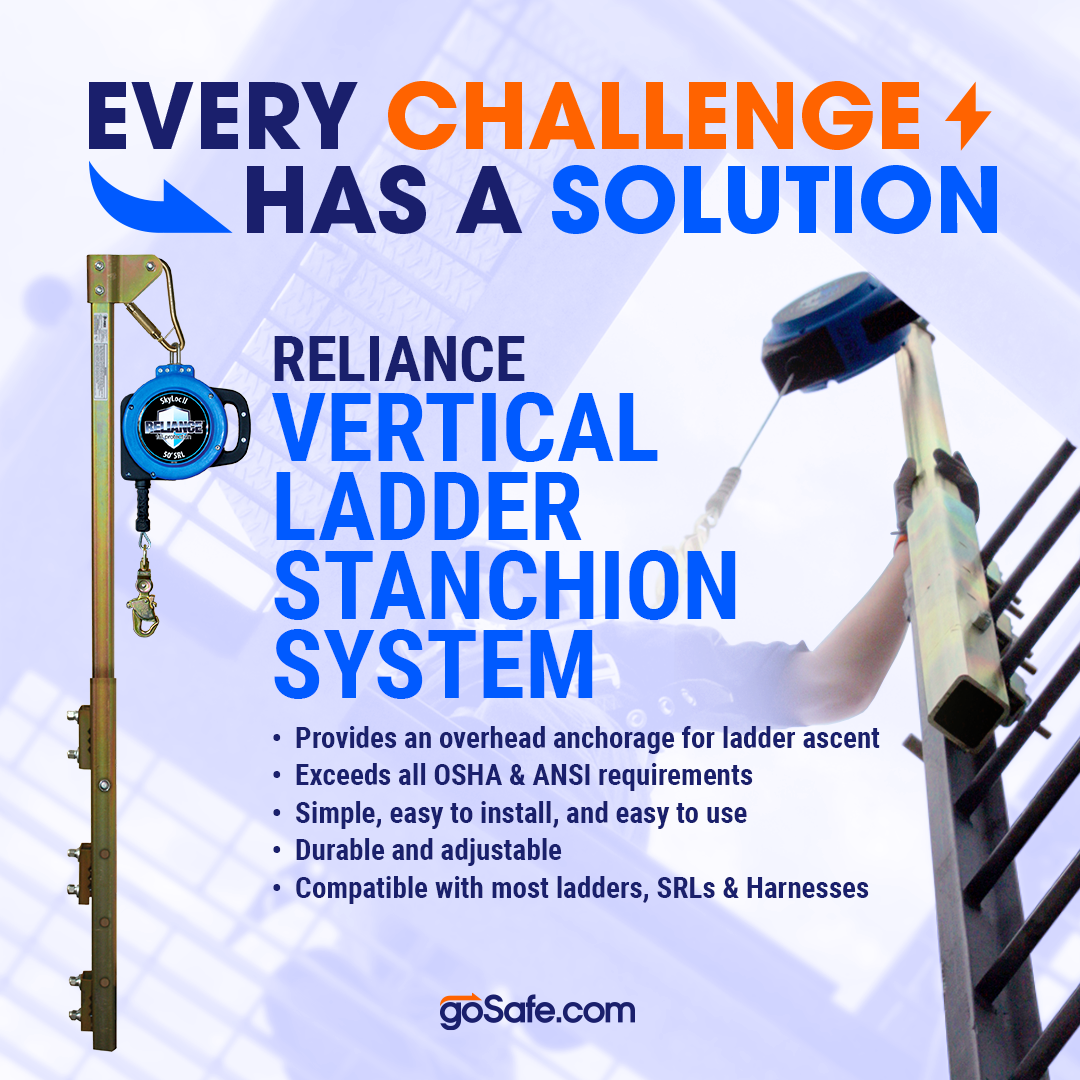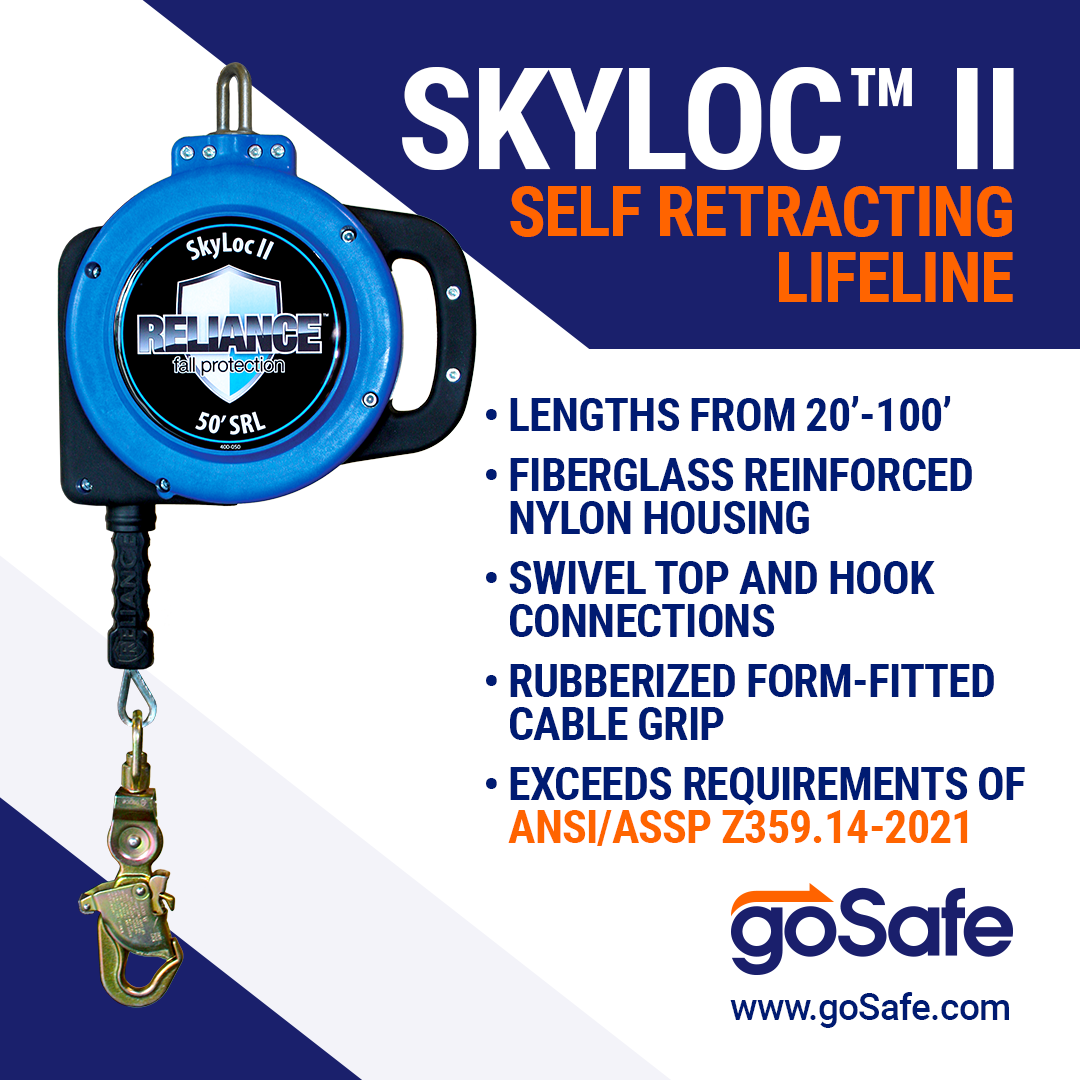Changes made several years ago to OSHA’s Walking/Working Surfaces regulations continue to generate questions such as “Are ladder cages still OSHA compliant?” and “When will a Personal Fall Arrest System (such as a davit mounted SRL) or Ladder Safety System (engineered cable/rail system) be required on a fixed ladder?” In this article, we will explain the standards in place, how they affect existing ladders, and what steps you will have to take in order to remain compliant in the future. This is an admittedly confusing topic; hopefully we'll be able to clear up that confusion and set the record straight.
In 2016, OSHA 1910 was updated. With this update, the previous requirements and standards for fixed ladders with cages are phasing out in favor of Personal Fall Arrest Systems (PFAS) and Ladder Safety Systems. OSHA 1910.28(b)(9) lays out the new requirements regarding both new and existing fixed ladders, PFAS and ladder safety systems, and the related compliance deadlines.
The new regulations went into effect on November 19, 2018. They require specific measures of protection for any fixed ladder extending more than 24 feet above a lower level. Under this new regulation:
- Any ladder installed before that date must have a PFAS, cage, ladder safety system, or well. 1910.28(b)(9)(i)(A)
- Any ladder installed on or after that date must have a personal fall arrest system or a ladder safety system installed. 1910.28(b)(9)(i)(B)
This means that any fixed ladder installed ON or AFTER November 19, 2018 that utilizes a cage or well and does NOT have a ladder safety system or PFAS installed, will NOT comply with current OSHA requirements. In addition, "When a fixed ladder, cage, or well, or any portion of a section thereof is replaced, a personal fall arrest system or ladder safety system must be installed in at least that section of the fixed ladder, cage, or well where the replacement is located." (1910.28(b)(9)(i)(C)).
November 18, 2036 is the final deadline for all existing fixed ladders to be brought into compliance with the new OSHA regulations. "On this date, all fixed ladders must have an attached PFAS or ladder safety system." 1910.28(b)(9)(i)(D). At this time, any fixed ladder using only a well or cage will be considered non-compliant by OSHA. Interestingly enough, existing cages or wells may remain in place as long as they don’t interfere with the required safety systems.
OSHA Standard # |
Regulation |
|
Each existing fixed ladder installed before November 19, 2018 must be equipped with a personal fall arrest system, ladder safety system, cage, or well |
|
|
Each fixed ladder installed on and after November 19, 2018 must be equipped with a personal fall arrest system or a ladder safety system |
|
|
When a fixed ladder, cage, or well, or any portion of a section thereof, is replaced, a personal fall arrest system or ladder safety system must be installed in at least that section of the fixed ladder, cage, or well where the replacement is located |
|
|
On and after November 18, 2036, all fixed ladders must be equipped with a personal fall arrest system or a ladder safety system. |
Possible Scenarios & Compliance: Q&A
Let's examine some possible scenarios and discuss both compliance with requirements and best practices in this Q&A:
Q: Isn't a ladder cage or well considered to be a ladder safety system?
A: NO - Cages and wells are not personal fall arrest systems, nor are they considered ladder safety systems, which is why the language in the regulation differentiates between the four terms. Unfortunately for a more definitive look and OSHA’s intent, one must review the “Final Rule”. The final rule includes definitions and origins and rationale for the definition.
Defining Ladder Safety System”: In the final rule, a ladder safety system is defined as "A system designed to eliminate or reduce the possibility of falling from a ladder". The final definition explains that "...a ladder safety system usually consists of a carrier; a safety sleeve, which is a moving component that travels on the carrier; a lanyard; connectors; and a body harness." The final definition also specifies that cages and wells are NOT ladder safety systems.
The existing rule in Sec. 1910.21(e)(13) uses a similar term, "ladder safety device", which also excludes ladder cages and wells. OSHA's construction ladder standard in Sec. 1926.1053 uses the same term, but does not include a definition of the term. The final definition is consistent with the ANSI fixed-ladder standard (ANSI A14.3-2008; Section 3)
So, if we take into account the highlighted text out of the definitions in the Final Rule, then OSHA’s position is abundantly clear: Cages and wells are NOT fall protection and while they aren’t prohibited, a ladder featuring a cage or a well installed after the November, 2018 deadline that does not also have a personal fall arrest system or ladder safety system installed does NOT comply with OSHA regulations and is a liability.
Q: "I have an existing caged ladder. If I add a PFAS or ladder safety system to it, will I be compliant?"
A: The simple answer here is YES. However, there are other factors to consider - even for something that seems so simple.
- For example, OSHA's ruling applies to ladders that are 24 feet or higher above a lower level. If the ladder is less than 24 feet, not only is a PFAS or vertical system not required, there is also no requirement for a ladder cage. Adding a safety system is of course a best-practice, but in this case not required for compliance.
- If the ladder IS 24 feet or more above a lower level, the variable then becomes the installation date. If the ladder was installed prior to November 2018, a cage alone would make the ladder OSHA compliant until the 2036 deadline. If however the ladder was installed after November 2018, a ladder safety system or PFAS would be required, even if the ladder is caged.
Q: Do the updated OSHA standards require me to remove ladder cages?
A: NO, the regulations do not require removal of existing cages. On this topic, OSHA states the following:
The employer may use a cage or well in combination with a personal fall arrest system or ladder safety system provided that the cage or well does not interfere with the operation of the system. 1910.28(b)(9)(iv). So, there is no need for removal prior to the final 2036 deadline if the cage does not interfere with the operation of a ladder safety system.
Why Not Continue to Use Ladder Cages?
Ladder cages do not arrest falls, and it's not just because they are not defined as fall protection. Ladder cages have the potential of giving climbers a false sense of security, when all they tend to do in the event of a fall is ensure that the climber lands at the bottom of the ladder. This is assuming that the climber's limbs don't get stuck in the cage during fall. Ladder cages also make rescue complicated - an incapacitated worker is much more difficult to rescue from a caged ladder than a climber attached to a cable or rail lifeline system.
At goSafe, we encourage you to make ladder fall protection decisions based on “best practices” as opposed to just meeting OSHA’s minimal fall protection requirements. Postponing lifeline installations on ladders that will require it is likely a mistake, as there will inevitably be a rush towards compliance, as the deadline nears. The added protection of a PFAS or ladder safety system creates a safer work environment for everyone.
PLEASE NOTE: As a reminder, any new projects over 24 feet that require a ladder safety system or PFAS do NOT require cages. The safety benefits of leaving the cage off are complimented by the cost savings and lack of restraint placed on workers who are using the ladder.
For more comprehensive information on this topic, please visit CLICK HERE.
CLICK HERE TO VISIT OUR CAGED LADDER FAQ PAGE.
goSafe offers a variety of Ladder Safety Systems designed to ensure the safety of anyone climbing a fixed ladder. Ladder Stanchion Systems are available in multiple materials and configurations, as standalone stanchions or as complete systems including an SRL. Ladder Davits with a Mechanical Lift make traversing fixed ladders through a ceiling hatch safe and easy. For more information on these systems and other Fall Protection equipment from Reliance, contact us at sales@gosafe.com
goSafe: Your Partner in Safety
At goSafe, Safety is our ONLY focus - and we'll partner with you to keep you and your teams safe. We're small enough to handle your local projects, yet large enough to serve national accounts. If safety is your mission, it starts with us.
Watch the video below for more information about goSafe's capabilities.
Are you on the lookout for more information on fall protection use? Visit our FAQ page today! There, you’ll find some bonus tips to help get you started.








